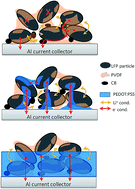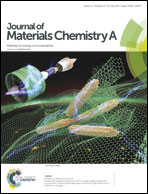Judicious design of lithium iron phosphate electrodes using poly(3,4-ethylenedioxythiophene) for high performance batteries†
Abstract
LiFePO4 electrodes were built in different architectures using a poly(3,4-ethylenedioxythiophene)-polystyrene sulfonate (PEDOT:PSS) mixed conductor as an additive. Conductivity enhancement of PEDOT:PSS was achieved by the addition of ethylene glycol and dimethyl sulfoxide solvents. The amounts of conducting polymer and solvent additives strongly influence the discharge capacity and potential of LiFePO4 electrodes at high rates. The initial impedance and the direct current resistance were correlated with the discharge performance at high rates. The optimized amount of PEDOT:PSS added within the bulk resulted in a lower value of impedance, lower load resistance and higher capacity as compared to the standard preparation. Furthermore 57Fe Mössbauer spectroscopy and X-ray photoelectron spectroscopy were employed to probe the bulk transformation of the LiFePO4 active material and the surface changes of the composite electrodes with the conducting polymer upon lithiation. The electrode with PEDOT:PSS coated on the aluminium current collector and doped with ethylene glycol showed highly competitive performance (132 mA h g−1 at 5 C and 145 mA h g−1 at 2 C for 50 cycles).


 Please wait while we load your content...
Please wait while we load your content...